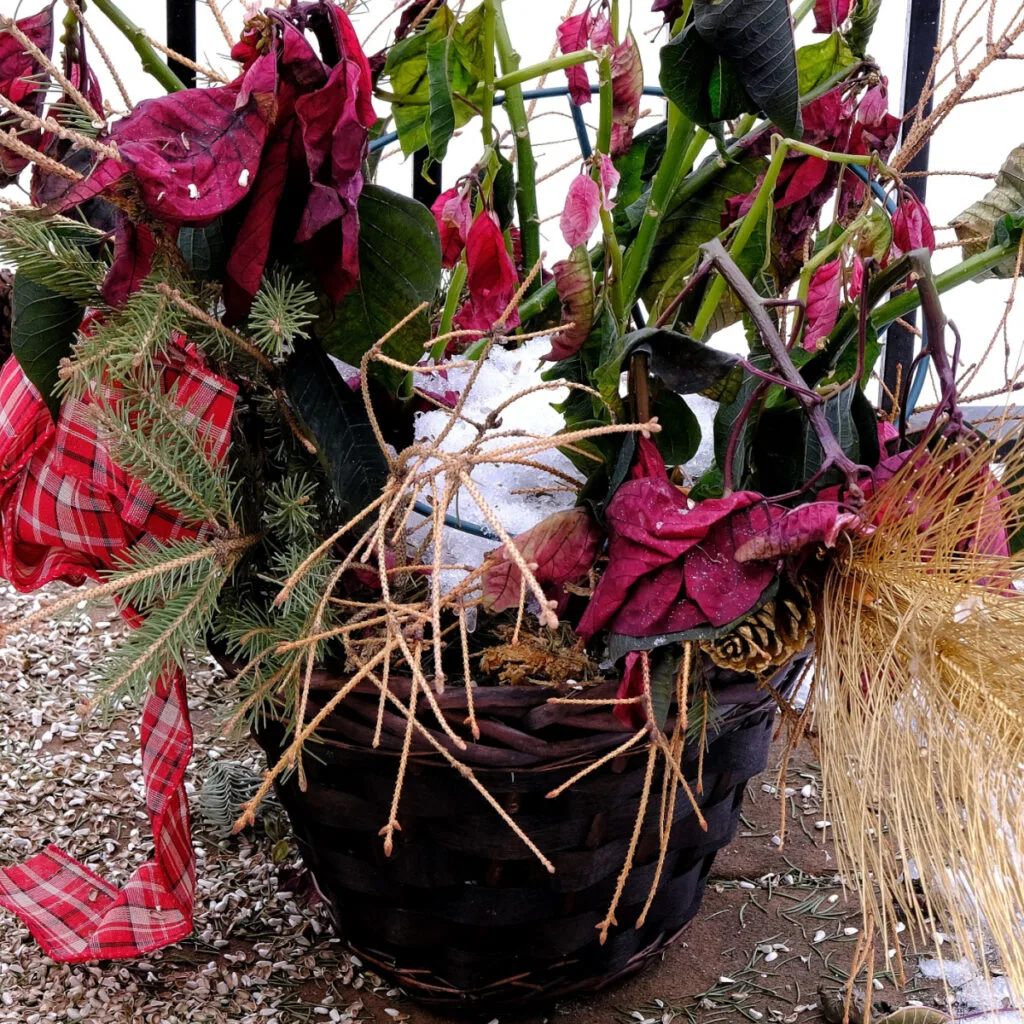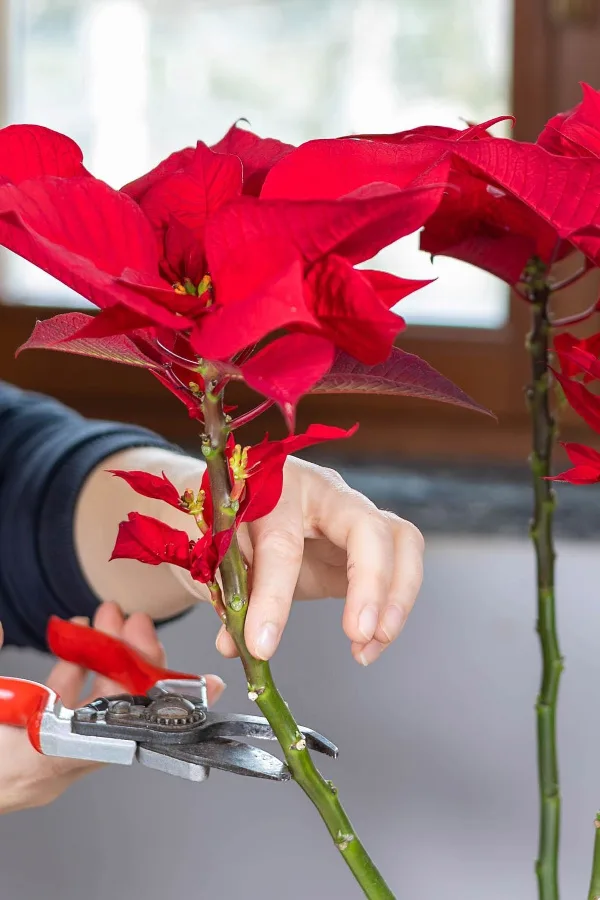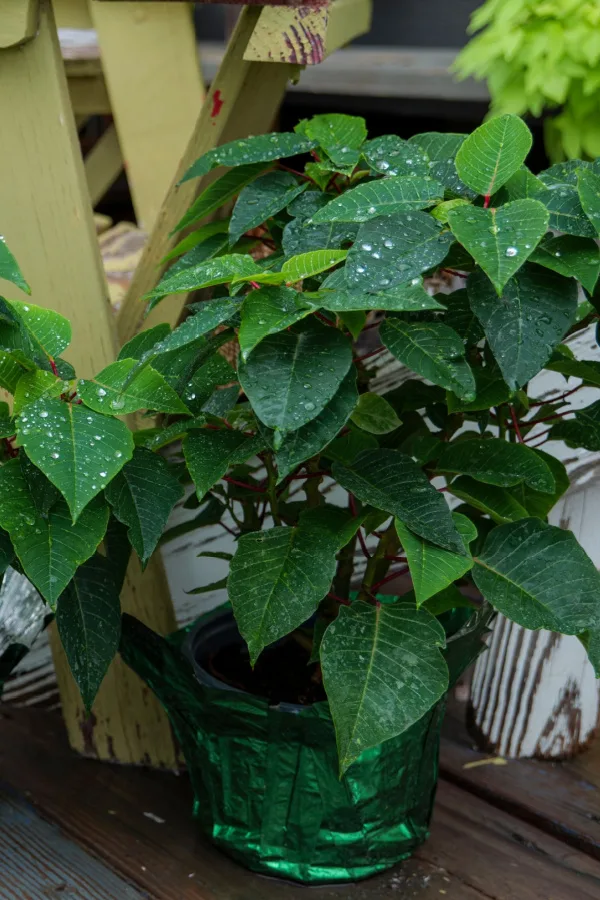Wondering what to do with your poinsettia plants after they bloom and begin to lose their beautifully colored leaves?
Without a doubt, poinsettia plants are the go-to plant when it comes to holiday decorating. In fact, so popular that more poinsettias are sold as potted plants than any other plant in the United States. That includes any potted plants sold at any time of the year!
But as popular as they are, poinsettias are also one of the most misunderstood plants. Especially when it comes to the question of what to do with them after they begin to lose their luster and blooms at the end of the holiday season.

Unfortunately, all too often, poinsettia plants simply get tossed to the curb in late December or early January. Once their once-gorgeous colorful leaves start to brown off and fall to the floor, many think the plant has reached the end of the line – much like annuals like marigolds, impatiens and other summer blooming annuals do in late fall.
But here’s the good news – the poinsettia plant is actually a perennial. And one that can actually quite easily be kept alive as a beautiful houseplant after it completes its blooming cycle. Even better, it can also be made to bloom just as bright and beautiful next holiday season as well!
One thing is for sure, when you consider just how costly poinsettias can be, it can be a great way to save on your annual holiday decorating budget. And – have a great houseplant for the rest of the year too!
What To Do With Poinsettia Plants After They Bloom
How To Save Your Poinsettia Plant – Cutting Your Poinsettia Back
By mid-January, even the most well-kept poinsettia plants begin to fade. Their colorful blooms (actually showy leaves called bracts) finally start to fall from the plant. As they do, the plant starts to look quite spindly and weak.

Unfortunately, many think the plant is struggling at this point to survive. In reality, it’s simply going through the same process all perennials go through when they complete their blooming cycle. And just as you do with other perennials, that means it’s time for a major pruning.
When pruning back, wear gloves if you have sensitive skin. Poinsettias release a milky white sap that can be an irritant for many to the skin.
A good rule of thumb is to cut plants back to about 4 to 6 inches above the soil surface of the pot. Using a sharp pair of hand pruners, cut back stems at a 45° angle. This will help the cuts heal over more easily and stop the sap flow much faster.
If there are any green, healthy leaves below the 4 to 6 inch level, allow them to remain. Know that at this point your poinsettia is going to look more like a Charlie Brown Christmas tree than a houseplant – but don’t be alarmed – it will survive and thrive once again.

Post Pruning Care – What To Do With Poinsettia Plants After They Bloom
Now it’s time to revive your plant and grow a new leaf canopy for your poinsettia. After pruning, place your plant in a sunny windowsill. Water your plant as needed to keep the soil slightly moist. Be careful not to overwater as poinsettia roots can rot when sitting water.
Usually, within 2 to 3 weeks, you will begin to see new growth beginning to emerge from the stems. When this new growth appears, it’s time to give your plant a boost of energy by fertilizing. For best results, use a balanced fertilizer designed with houseplants in mind. Affiliate Product Link: Schultz All Purpose Liquid Plant Food 10-15-10
You poinsettia plant will continue to grow an entirely new leaf canopy throughout the rest of winter and early spring. Continue fertilizing monthly to help the plant re-energize its roots and leaf structure.
As spring and warmer temperatures arrive, you can take the plants outside. The more sun the better. In fact, you can even plant them directly into the soil if desired. Prune back the plants a few inches in early summer and again in mid-summer to keep the plant more full and bushier.

Fall Care – What To Do With Poinsettia Plants After They Bloom
As fall arrives, it’s time to start preparing your poinsettia for holiday blooming. To get plants to bloom around the holiday season, they need to go through a 6 to 8 week period of darkness to force the blooms.
At the end of September, place your poinsettia in a dark, cool area. Aim for an area that is around 65° to 70°(f) and keep your plants dark for around 14 to 16 hours a day. A dark closet or basement with easy access works best for this. Continue to water as needed through the process.
Bring the plant out into indirect light for only about 8 to 10 hours each day and then return to darkness. As soon as you see the blooms begin to change color, it is time to bring it out full time to enjoy.
Here is to saving your poinsettia plants. Not only can you save on repurchasing – but you can have a great houseplant to boot! For even more on holiday plant care – see our article: How To Keep Your Christmas Cactus Healthy – Before & After Christmas!
Happy Gardening – Jim and Mary
Old World Garden Farms

Jim and Mary Competti have been writing gardening, DIY and recipe articles and books for over 15 years from their 46 acre Ohio farm. The two are frequent speakers on all things gardening and love to travel in their spare time.
As always, feel free to email us at thefarm@owgarden.com with comments, questions, or to simply say hello! You can sign up for our free email list in the subscribe now box in the middle of this article. Follow us on Facebook here : OWG Facebook. This article may contain affiliate links.
